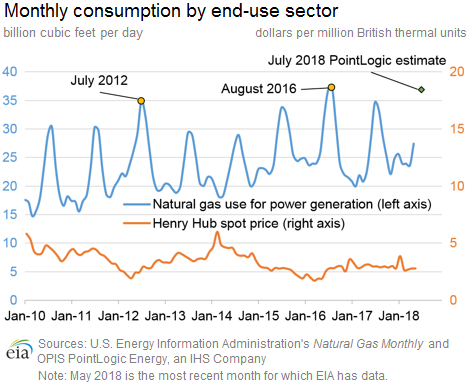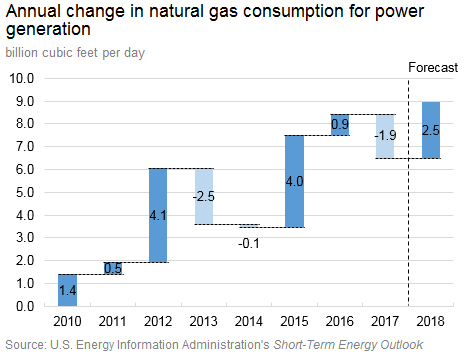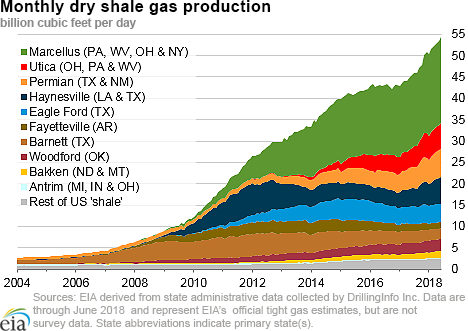In the News:
July approaches record monthly natural gas use for power generation
Natural gas consumption for power generation (power burn) this July approached the all-time record monthly level. PointLogic Energy estimates that July power burn averaged 36.9 billion cubic feet per day (Bcf/d). Data from the U.S. Energy Information Administration’s Natural Gas Monthly indicate the highest average level of power burn in any month (through May 2018) was 37.2 Bcf/d in August 2016. July and August typically have the highest power burn because they are the hottest months, which generally results in high cooling demand.
July’s high power burn is consistent with long-term trends in natural gas consumption. Most natural gas consumption growth in recent years has come from the electric power and industrial sectors. From 2010 to 2017, power burn grew by an average of 0.8 Bcf/d annually, and industrial consumption of natural gas (including lease and plant fuel) grew by an average of 0.7 Bcf/d.
Power burn is highly variable because it is based on weather and the dispatch prioritization, which is largely based on the price competitiveness of natural gas. Power burn reached 34.9 Bcf/d in July 2012, a monthly record that stood for several years. The unusually warm winter of 2011/2012, combined with rising levels of natural gas production, led to record-high storage inventories that caused low natural gas prices during the summer season and resulted in higher power burn. The same factors combined again in 2016 when high levels of natural gas in storage and rising production led to low natural gas prices and record levels of power burn.
Although short-term price and supply considerations set the fuel mix for power generation, the long-term trend in the power sector is increasing generation of electricity from natural gas. The combination of relatively low natural gas prices, environmental regulations, and supportive renewable energy policies has led the industry to build new natural gas-fired and renewable capacity and to retire coal-fired power plants.
Overview:
(For the Week Ending Wednesday, August 1, 2018)
- Natural gas spot prices rose at most locations this report week (Wednesday, July 25 to Wednesday, August 1). Henry Hub spot prices rose from $2.77 per million British thermal units (MMBtu) last Wednesday to $2.80/MMBtu yesterday.
- At the New York Mercantile Exchange (Nymex), the August 2018 contract expired Friday at $2.822/MMBtu. The September 2018 contract price remained unchanged from last Wednesday to yesterday at $2.758/MMBtu.
- Net injections into working gas totaled 35 billion cubic feet (Bcf) for the week ending July 27. Working natural gas stocks are 2,308 Bcf, which is 23% lower than the year-ago level and 20% lower than the five-year (2013–17) average for this week.
- The natural gas plant liquids composite price at Mont Belvieu, Texas, rose by 38¢, averaging $9.04/MMBtu for the week ending August 1. The prices of propane and butane both rose by 6%, and the prices of natural gasoline, ethane, and isobutane rose by 3%, 1%, and 5%, respectively.
- According to Baker Hughes, for the week ending Tuesday, July 24, the natural gas rig count decreased by 1 to 186. The number of oil-directed rigs rose by 3 to 861. The total rig count increased by 2, and it now stands at 1,048.
Prices/Supply/Demand:
Prices rise outside the Southwest. This report week (Wednesday, July 25 to Wednesday, August 1), Henry Hub spot prices rose 3¢ from $2.77/MMBtu last Wednesday to $2.80/MMBtu yesterday. At the Chicago Citygate, prices increased 4¢ from $2.69/MMBtu last Wednesday to $2.73/MMBtu yesterday.
Prices at SoCal Citygate in California were lower than last week’s record high but remained elevated amid hot weather. Overall, prices decreased $5.28 from $15.02/MMBtu last Wednesday to $9.74/MMBtu yesterday, with a low of $8.22/MMBtu on Monday. Prices at PG&E Citygate in Northern California rose 4¢, up from $3.17/MMBtu last Wednesday, to $3.21/MMBtu yesterday.
Prices at the Waha Hub in West Texas, which is located near Permian Basin production activities, averaged $1.84/MMBtu last Wednesday, 93¢ lower than the Henry Hub price. Yesterday, prices at the Waha Hub averaged $2.23/MMBtu, 57¢ lower than Henry Hub prices.
Prices rise in the Northeast. At the Algonquin Citygate, which serves Boston-area consumers, prices went up 26¢ from $2.82/MMBtu last Wednesday to $3.08/MMBtu yesterday. At the Transcontinental Pipeline Zone 6 trading point for New York City, prices increased 4¢ from $2.88/MMBtu last Wednesday to $2.92/MMBtu yesterday, with a low of $2.81/MMBtu on Friday.
Tennessee Zone 4 Marcellus spot prices increased 19¢ from $2.26/MMBtu last Wednesday to $2.45/MMBtu yesterday. Prices at Dominion South in southwest Pennsylvania rose 12¢ from $2.41/MMBtu last Wednesday to $2.53/MMBtu yesterday.
August Nymex contract expires up while September contract remains unchanged. At the Nymex, the August 2018 contract expired Friday at $2.822/MMBtu, up 5¢ from last Wednesday. The September 2018 contract remained unchanged Wednesday to Wednesday at $2.758/MMBtu. The price of the 12-month strip averaging September 2018 through August 2019 futures contracts declined 2¢ to $2.756/MMBtu.
Supply remains unchanged. According to data from PointLogic Energy, the average total supply of natural gas remained the same as in the previous report week, averaging 86.7 Bcf/d. Dry natural gas production remained constant week over week. Average net imports from Canada decreased by 4% from last week.
May sets a production record. According to EIA’s most recent Natural Gas Monthly, May 2018 dry natural gas production averaged 80.4 Bcf/d, the highest level since EIA began tracking dry natural gas production in 1973. The previous record was 79.5 Bcf/d in March 2018.
Demand falls. Total U.S. consumption of natural gas fell by 1% compared with the previous report week, according to data from PointLogic Energy. Natural gas consumed for power generation declined by 4% week over week as temperatures moderated somewhat in the Southwest. Industrial sector consumption stayed constant, averaging 19.9 Bcf/d. In the residential and commercial sectors, consumption increased by 8% but remains a minor source of consumption during the summer months. Natural gas exports to Mexico increased 2%.
U.S. liquefied natural gas (LNG) exports are flat week over week. Six LNG vessels (combined LNG-carrying capacity 21.6 Bcf) departed the United States from July 26 through August 1 (five from the Sabine Pass liquefaction terminal and one from Cove Point). One LNG tanker (capacity 3.4 Bcf) was loading at Sabine Pass on Wednesday.
In July, a total of 30 LNG cargoes were exported from the United States―23 cargoes from Sabine Pass, and 7 cargoes from Cove Point―for an estimated total export volume of 103.6 Bcf. This level is the highest monthly LNG export volume on record since U.S. LNG exports began in February 2016.
Storage:
Net injections are lower than the five-year average for the fifth week in a row. Net injections into storage totaled 35 Bcf for the week ending July 27, compared with the five-year (2013–17) average net injections of 43 Bcf and last year's net injections of 18 Bcf during the same week. Working gas stocks totaled 2,308 Bcf, which is 565 Bcf lower than the five-year average and 688 Bcf lower than last year at this time.
Working gas stocks are below the five-year range for the first time since 2014. Net injections into storage are 19% lower than the five-year average rate so far in the 2018 refill season. If working gas stocks match the five-year average rate of injections of 9.6 Bcf/d for the remainder of the refill season, inventories will total 3,250 Bcf on October 31, 310 Bcf lower than the five-year low of 3,560 Bcf. In the Lower 48 states, total working gas stocks are currently 13 Bcf and 51 Bcf lower than the five-year range in the East and Midwest regions, respectively. The South Central region posted working gas stocks that are 60 Bcf higher than the bottom of the five-year range, with the nonsalt facilities 67 Bcf higher than its lower bound.
Despite relatively low storage inventories, the average January 2019 futures contract price trades at a lower premium to the average spot price than last year at this time. Price differences between the spot price and the futures prices at the Nymex indicate limited economic incentives for net injections into working gas. During the most recent storage week, the average natural gas spot price at the Henry Hub averaged $2.75/MMBtu while the Nymex futures price of natural gas for delivery in January 2019 averaged $3.00/MMBtu, 25¢/MMBtu higher than the spot price. A year ago, the January contract was 31¢/MMBtu higher than the spot price.
Reported net injections into storage are below the median of the range of analysts’ expections. According to The Desk survey of natural gas analysts, estimates of the weekly net change from working natural gas storage ranged from net injections of 24 Bcf to 46 Bcf, with a median estimate of 42 Bcf. At the 10:30 a.m. release of the Weekly Natural Gas Storage Report (WNGSR), the price of the Nymex futures contract for September delivery at the Henry Hub increased 3¢/MMBtu to $2.79/MMBtu, with 1,624 trades executed. Prices varied in subsequent trading, but remained close to $2.79/MMBtu.
Temperatures are in the higher-than-normal range for the storage week. Temperatures in the Lower 48 states averaged 77 degrees Fahrenheit (°F), 2°F higher than normal and the same as last year at this time. Temperatures were 11°F lower than the level reported for the previous week.
See also:
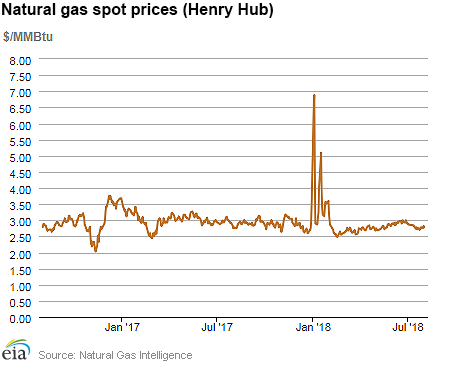
| Spot Prices ($/MMBtu) | Thu, 26-Jul |
Fri, 27-Jul |
Mon, 30-Jul |
Tue, 31-Jul |
Wed, 1-Aug |
|---|---|---|---|---|---|
| Henry Hub | 2.78 | 2.78 | 2.76 | 2.82 | 2.80 |
| New York | 2.88 | 2.81 | 2.87 | 2.91 | 2.92 |
| Chicago | 2.70 | 2.65 | 2.69 | 2.73 | 2.73 |
| Cal. Comp. Avg,* | 4.06 | 3.15 | 3.30 | 3.32 | 3.63 |
| Futures ($/MMBtu) | |||||
| August Contract | 2.780 | 2.822 | Expired | Expired | Expired |
| September Contract | 2.762 | 2.782 | 2.797 | 2.782 | 2.758 |
| October Contract | 2.780 | 2.800 | 2.817 | 2.798 | 2.770 |
| *Avg. of NGI's reported prices for: Malin, PG&E Citygate, and Southern California Border Avg. | |||||
| Source: NGI's Daily Gas Price Index | |||||
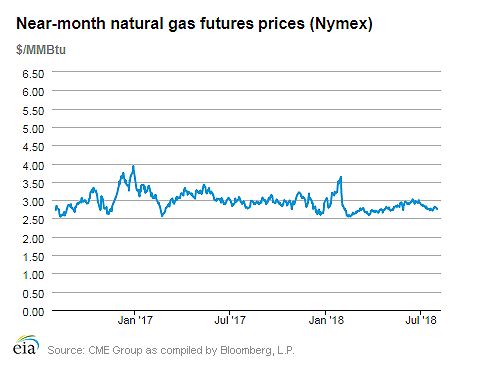
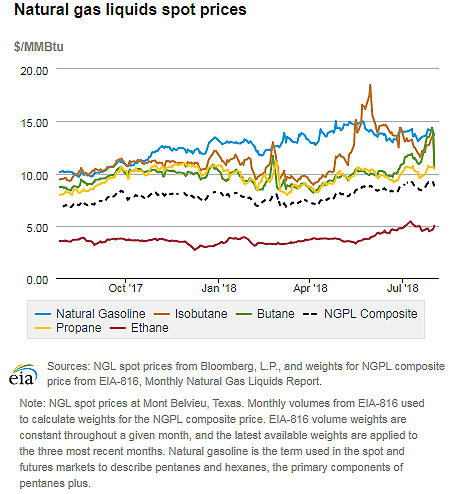
| U.S. natural gas supply - Gas Week: (7/26/18 - 8/1/18) | |||
|---|---|---|---|
Average daily values (Bcf/d): |
|||
this week |
last week |
last year |
|
| Marketed production | 91.9 |
91.8 |
83.0 |
| Dry production | 81.1 |
81.0 |
73.4 |
| Net Canada imports | 5.6 |
5.8 |
5.9 |
| LNG pipeline deliveries | 0.1 |
0.1 |
0.0 |
| Total supply | 86.7 |
86.8 |
79.3 |
|
Source: OPIS PointLogic Energy, an IHS Company | |||
| U.S. natural gas consumption - Gas Week: (7/26/18 - 8/1/18) | |||
|---|---|---|---|
Average daily values (Bcf/d): |
|||
this week |
last week |
last year |
|
| U.S. consumption | 63.5 |
64.2 |
60.0 |
| Power | 35.4 |
36.8 |
34.4 |
| Industrial | 19.9 |
19.9 |
19.6 |
| Residential/commercial | 8.2 |
7.6 |
5.9 |
| Mexico exports | 4.7 |
4.6 |
4.5 |
| Pipeline fuel use/losses | 6.8 |
6.9 |
6.5 |
| LNG pipeline receipts | 3.5 |
3.2 |
2.3 |
| Total demand | 78.5 |
78.9 |
73.3 |
|
Source: OPIS PointLogic Energy, an IHS Company | |||
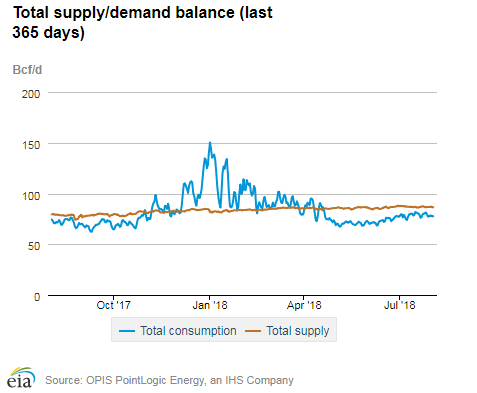
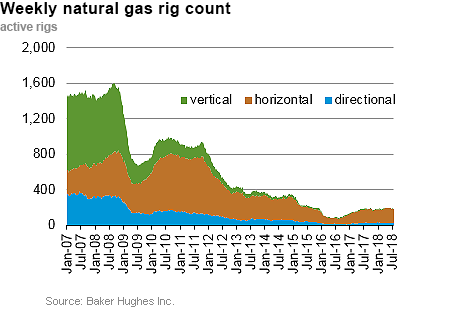
| Rigs | |||
|---|---|---|---|
Tue, July 24, 2018 |
Change from |
||
last week |
last year |
||
| Oil rigs | 861 |
0.3% |
12.4% |
| Natural gas rigs | 186 |
-0.5% |
-3.1% |
| Note: Excludes any miscellaneous rigs | |||
| Rig numbers by type | |||
|---|---|---|---|
Tue, July 24, 2018 |
Change from |
||
last week |
last year |
||
| Vertical | 62 |
8.8% |
-12.7% |
| Horizontal | 922 |
0.0% |
13.8% |
| Directional | 64 |
-4.5% |
-16.9% |
| Source: Baker Hughes Inc. | |||
| Working gas in underground storage | ||||
|---|---|---|---|---|
Stocks billion cubic feet (Bcf) |
||||
| Region | 2018-07-27 |
2018-07-20 |
change |
|
| East | 552 |
527 |
25 |
|
| Midwest | 552 |
524 |
28 |
|
| Mountain | 146 |
145 |
1 |
|
| Pacific | 250 |
257 |
-7 |
|
| South Central | 808 |
820 |
-12 |
|
| Total | 2,308 |
2,273 |
35 |
|
| Source: Form EIA-912, "Weekly Underground Natural Gas Storage Report" | ||||
| Working gas in underground storage | |||||
|---|---|---|---|---|---|
Historical comparisons |
|||||
Year ago (7/27/17) |
5-year average (2013-2017) |
||||
| Region | Stocks (Bcf) |
% change |
Stocks (Bcf) |
% change |
|
| East | 647 |
-14.7 |
650 |
-15.1 |
|
| Midwest | 752 |
-26.6 |
707 |
-21.9 |
|
| Mountain | 200 |
-27.0 |
178 |
-18.0 |
|
| Pacific | 293 |
-14.7 |
313 |
-20.1 |
|
| South Central | 1,104 |
-26.8 |
1,025 |
-21.2 |
|
| Total | 2,996 |
-23.0 |
2,873 |
-19.7 |
|
| Source: Form EIA-912, "Weekly Underground Natural Gas Storage Report" | |||||
| Temperature – heating & cooling degree days (week ending Jul 26) | ||||||||
|---|---|---|---|---|---|---|---|---|
HDD deviation from: |
CDD deviation from: |
|||||||
| Region | HDD Current |
normal |
last year |
CDD Current |
normal |
last year |
||
| New England | 1 |
-1 |
-7 |
57 |
12 |
16 |
||
| Middle Atlantic | 1 |
-2 |
-1 |
66 |
7 |
-2 |
||
| E N Central | 1 |
-2 |
-1 |
50 |
-8 |
-17 |
||
| W N Central | 1 |
-2 |
1 |
60 |
-12 |
-34 |
||
| South Atlantic | 0 |
0 |
0 |
92 |
-6 |
-22 |
||
| E S Central | 0 |
0 |
0 |
88 |
-7 |
-28 |
||
| W S Central | 0 |
0 |
0 |
150 |
24 |
8 |
||
| Mountain | 0 |
-3 |
0 |
106 |
26 |
21 |
||
| Pacific | 0 |
-3 |
0 |
83 |
37 |
24 |
||
| United States | 0 |
-2 |
0 |
83 |
8 |
-4 |
||
|
Note: HDD = heating degree day; CDD = cooling degree day Source: National Oceanic and Atmospheric Administration | ||||||||
Average temperature (°F)
7-Day Mean ending Jul 26, 2018
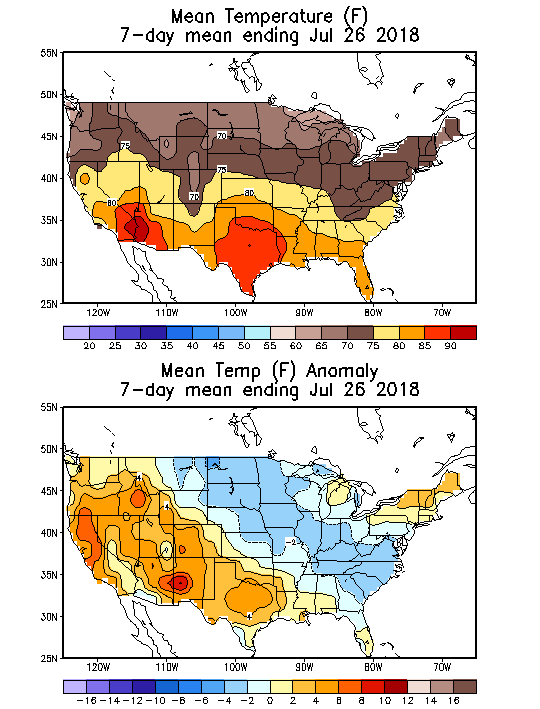
Source: NOAA National Weather Service
Deviation between average and normal (°F)
7-Day Mean ending Jul 26, 2018

Source: NOAA National Weather Service

